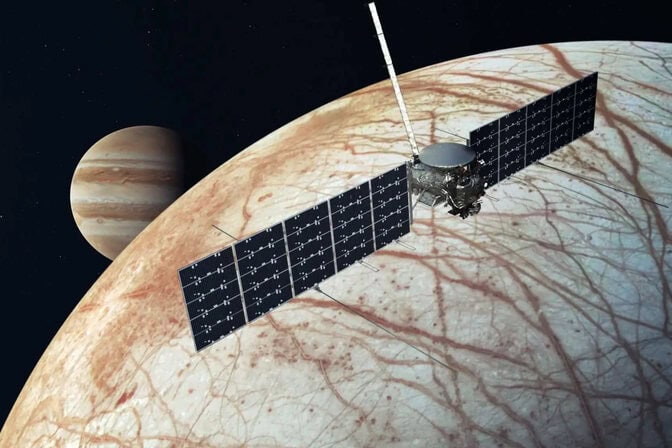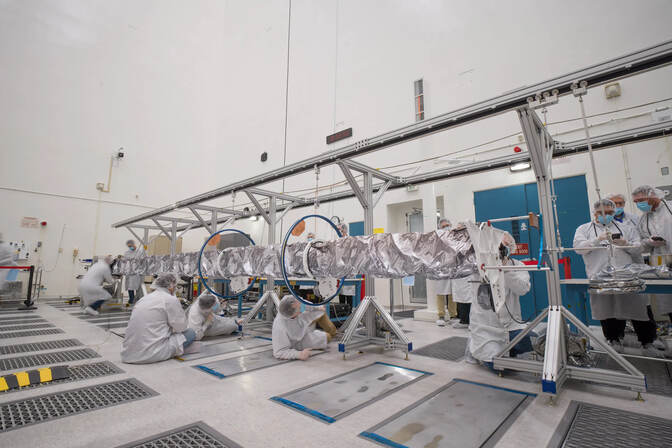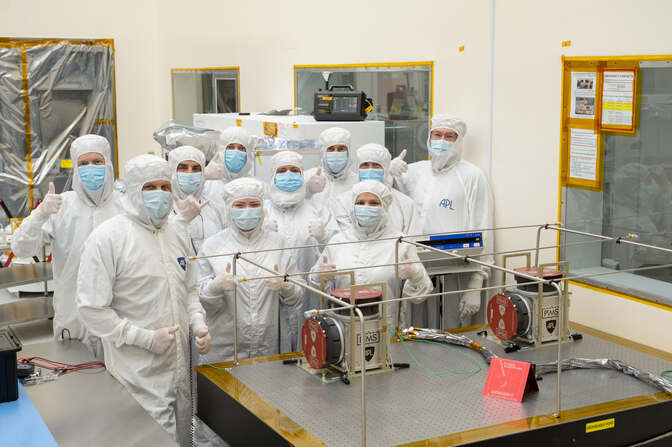
Could one of Jupiter’s moons support alien life? U-M scientists are on the case
U-M researchers helped find the first evidence for an ocean on the icy moon Europa. Now, with NASA’s return mission, they aim to learn if it’s habitable.

U-M researchers helped find the first evidence for an ocean on the icy moon Europa. Now, with NASA’s return mission, they aim to learn if it’s habitable.
Experts
NASA’s Europa Clipper, the organization’s latest mission to Jupiter’s system of moons, launched today from Florida’s Kennedy Space Center.
It’s the start of a grand journey to Europa, a moon that scientists believe has a salty ocean of water beneath its icy outer surface. When the spacecraft reaches its target in 2031, it will start collecting the data necessary for University of Michigan researchers to help determine whether the ocean could support life.
“For a long time, people have asked whether we are alone in the universe, and any evidence that life could exist on another planet or moon takes us a small step toward answering that question,” said Margaret Kivelson, a research professor of climate and space sciences and engineering at the University of Michigan and a professor emerita at the University of California, Los Angeles. She is also the team leader for Europa Clipper’s magnetometer, an instrument that will measure the magnetic fields of Europa and Jupiter.
Launching with optimism
Europa Clipper launched within its originally scheduled window, despite many setbacks. The first came in May 2024, when NASA engineers discovered that electrical switches called transistors in the spacecraft were failing at radiation levels lower than expected. Some worried that Clipper’s electronics might not withstand the high-intensity radiation in Jupiter’s magnetic field and that NASA might delay the mission for their engineers to work on a solution.
But after months of testing, NASA determined the transistors could function well enough to meet the mission’s objectives, in part because Clipper would only pass through the most intense levels of radiation once every 21 days. The agency cleared Europa Clipper’s original launch window in September 2024 only for Hurricane Milton to hit Florida days ahead of the mission’s first potential launch date. NASA had to scrap the first target date.
“Missions like this are not easy on people who get anxious,” said Kivelson. “But I’m an optimist. I assumed that everything would go beautifully.”

The source of Kivelson’s optimism is experience. She served as the principal investigator of the magnetometer on Galileo—a NASA mission with its own unfortunate circumstances and delays. The spacecraft was supposed to launch from a space shuttle in 1986 until the Challenger disaster forced NASA to pause all space shuttle missions. Galileo eventually launched three years later, but its journey to the red giant would take six years rather than the three-and-a-half originally anticipated.
But for all Galileo’s troubles, the mission proved scientifically invaluable. With the data from the spacecraft’s magnetometer, Kivelson and her colleagues discovered Europa’s subsurface ocean in the first place.
“We had to be very patient,” said Kivelson. “But the spacecraft lasted for eight years and made many passes by each of Jupiter’s moons, so it was a very productive enterprise.”
Finding a hidden ocean
The first step toward discovering Europa’s subsurface ocean was noticing its strange magnetic field. In most magnetized planets and moons in our solar system, the magnetic poles align closely with the geographic north and south poles. Instead, Europa’s magnetic poles were cutting across the moon.
“That was very puzzling, and we didn’t initially understand what we were looking at,” said Kivelson. “Eventually we realized that there was a physical phenomenon called magnetic induction, where if you put a material that conducts electricity into a magnetic field that changes with time, you can drive currents into the conductor. It’s the same mechanism behind an electric generator on Earth. If you move a wire in a magnetic field, you will drive a current in the wire.”
In Europa’s case, the time-varying magnetic field comes from Jupiter itself. The moon orbits Jupiter within the gas giant’s magnetic field, which is tilted ten degrees. Because of that tilt, and because of the moon’s elliptical orbit, the strength and orientation of the magnetic field around Europa regularly changes over Jupiter’s 10.5-hour day and as Europa orbits the red giant.
The only missing piece of the puzzle was the conducting layer on Europa. A metal core was out of the question because the magnetic fields induced on Europa could only have been made by a layer relatively close to the moon’s surface. A salty ocean of liquid water seemed the most likely explanation because images from ground telescopes and the Voyager missions had already shown that Europa’s crust was mostly ice. Thermal modeling of Europa had also suggested that the ice might melt closer to the moon’s interior.

“It was a speculation, but if we were correct, we knew that the poles of Europa’s magnetic field would flip at a different tilt of Jupiter’s magnetic field,” said Kivelson.
To be absolutely certain, Kivelson and her colleagues had to convince NASA to let them visit Europa again at a time when Jupiter’s magnetic field was pointed in the opposite direction. Such a flight wasn’t part of NASA’s original plan for Galileo, but the team’s hypothesis was too tantalizing for the agency to leave untested. In 2000, Kivelson and her colleagues got their request, and the data showed exactly what the researchers had predicted.
Further study of Europa lent more support for an ocean of liquid water. The moon’s icy surface is riddled with cracks and ridges that might hint at blocks of ice melting, shifting and refreezing on the moon’s surface. Plumes of liquid water may also erupt from those cracks, according to analyses of images from the Hubble Space Telescope and data from the Galileo spacecraft.
An alien Eden?

The discovery of an alien ocean immediately begs the question of lifeforms swimming beneath the moon’s icy crust.
“Everybody links water and life, and we got a lot of questions about the possibility of life on Europa,” said Kivelson. “People’s imagination has been captured by the idea of other creatures in environments outside Earth.”
The excitement around Europa encouraged 2.6 million people to participate in NASA’s Message in a Bottle campaign. The name of each participant is etched onto a dime-sized microchip that is now attached to a metal plate on Europa Clipper along with an engraved poem by Poet Laureate Ada Limón.
Whether or not Europa’s ocean could truly support life remains a mystery, however. Galileo’s data was insufficient to constrain the thickness of Europa’s ice shell and the depth and salinity of Europa’s ocean, two key parameters for determining habitability. Scientists need to know the ocean’s salinity to determine which chemical ingredients could be available for life, and if the ocean is too far below Europa’s surface, or doesn’t touch Europa’s rocky mantle, it is less likely to collect enough of those chemical ingredients for life to emerge.
Existing estimates of the ocean’s depth and salinity encompass a wide range. The ocean could be anywhere between 40 and 100 miles deep, and its ice crust could be between two and 18 miles thick. Estimates of the ocean’s salinity from the magnetic field data range from nearly fresh to nearly saturated with salt, but more recent lab and telescopic observations indicate Europa’s ocean is rich with sodium chloride, the most abundant salt in Earth’s ocean.
The uncertainty stems from a lack of data. Galileo only passed Europa 12 times. With so few passes, the researchers could only view one complete cycle of Europa’s changing magnetic environment—Jupiter’s day.
“That cycle told us about the integrated effect of the ocean’s thickness and salinity on Europa’s induced magnetic field. We couldn’t get those two ocean parameters separately,” said Xianzhe Jia, a professor of climate and space sciences and engineering at U-M, and the deputy team leader for Europa Clipper’s magnetometer.
But Europa’s elliptical orbit causes its surrounding magnetic field to also change over a longer cycle—the four-Earth day period required for the moon to complete a lap around Jupiter. Clipper will fly past Europa almost 50 times and get as close as 16 miles above the surface, allowing the science team to view this longer cycle for the first time.
“That time period provides a lower frequency signal that penetrates deeper into the ocean, whereas the higher frequency signal seen over a Jovian day penetrates relatively shallow depths,” said Jia. “We can combine both of these signals to separate the ocean’s thickness from its salinity.”
Unscrambling plasma and ocean
Europa’s orbit around Jupiter introduces other time-varying influences to its magnetic field that could complicate efforts to tweeze apart the ocean’s depth and salinity. The main concern is volcanic gas from the volcanic moon Io. That gas gets ionized and trapped inside Jupiter’s magnetic field, forming an electrically-conductive plasma that flows around Europa like a stream around a boulder.
If that plasma flow changes over time, it could also shape Europa’s magnetic field. Jia will combine the magnetometer’s measurements with measurements from another instrument aboard Europa Clipper, the Plasma Instrument for Magnetic Sounding, or PIMS, that will measure the density, temperature and flow of plasma near Europa. With that information, Jia can use computer models that his research group has developed at U-M to separate the magnetic signals that come from Jupiter’s plasma rather than Europa’s ocean.

“I’m thrilled to see those first results come in so we can form a clearer picture of what exactly the ocean looks like,” said Adrienn Luspay-Kuti, a planetary scientist at the Johns Hopkins University Applied Physics Laboratory and the principal investigator for the PIMS.
A habitable Europa isn’t necessary to prove that life can originate away from Earth, but it would become one of the closest candidates for finding extraterrestrial life. Scientists have found over 5000 planets in other solar systems, and more than 300 orbit their stars within the goldilocks zone suitable for life to evolve. All are light-years away, however, so it’s unlikely a probe will fly to any of them soon. Compared to those far-off worlds, Europa is in our backyard.
“If Europa turns out to be habitable, then that’s the first step of having a real chance to one day find life that originated outside Earth,” said Luspay-Kuti. “We’d have a pretty strong incentive to go back and try to get underneath the ice shell.”